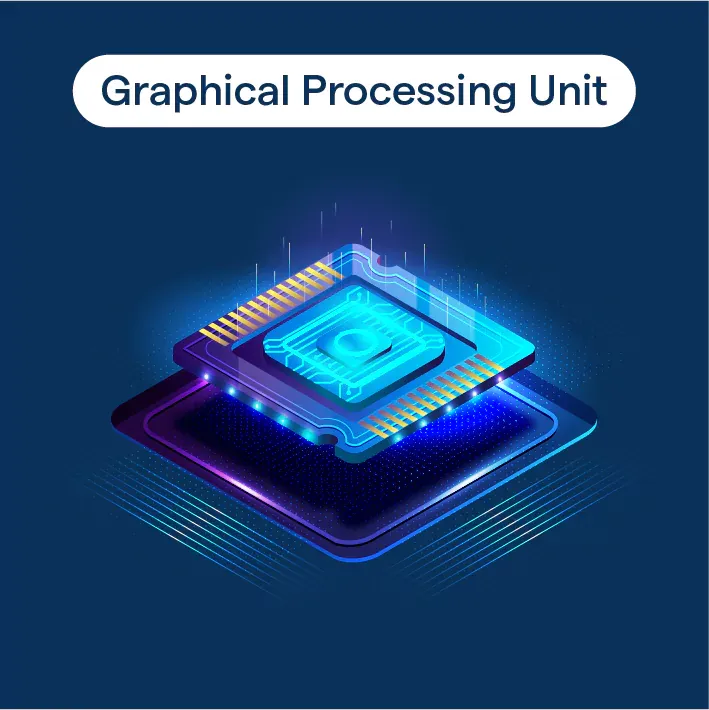What is a GPU (Graphical Processing Unit)?
A GPU, or Graphics Processing Unit, is a type of processor designed specifically to handle complex computations related to rendering images, animations, and videos on a computer screen. Unlike a CPU, which is focused on running the overall operations of a computer, a GPU is built to efficiently perform multiple calculations simultaneously, making it highly effective for tasks that involve a large amount of data, like graphics and deep learning algorithms. You can think of the GPU as the creative brain in your computer geared towards visual production—it turns binary data into stunning visual experiences.
Why do we need a GPU?
GPUs, or Graphics Processing Units, are essential pieces of computer hardware with roles that expand way beyond delivering high-quality graphics for games. Here's why we need them:
High-Resolution Graphics and Gaming
GPUs were initially designed for rendering high-quality graphics in video games. They deliver smooth performance even at very high resolutions and play a pivotal role in improving the gaming experience.
Accelerating Computer Processing
GPUs are designed to be parallel processors, capable of executing thousands of threads simultaneously. This ability makes them efficient at processing large blocks of data, thereby accelerating general computer processing.
Professional Visualizations
Whether it's 3D modeling and rendering in animation, architectural designs, or special effects in film production, GPUs provide the necessary computational power to manage these visual processes effectively.
Artificial Intelligence and Machine Learning
GPUs are instrumental in AI and Machine Learning operations. The parallel processing capability of GPUs makes them ideal for executing extensive calculations required by Deep Learning algorithms.
Cryptocurrency Mining
Cryptocurrency miners prefer using GPUs over CPUs for mining operations due to their advanced processing capabilities. They offer a better hash rate, increasing the efficiency of mining cryptocurrencies.
How does a GPU work?
A GPU, or Graphics Processing Unit, is a specialized piece of hardware built to handle graphic-intensive tasks. Here's a breakdown of how a GPU works:
Parallel Processing
GPUs have thousands of small, efficient cores designed for simultaneous processing. Unlike CPUs, which handle a few complex tasks, GPUs excel at executing numerous simple tasks concurrently, improving overall performance.
Rendering Graphics
GPUs are responsible for rendering graphics and converting data into images. They process vertices, apply textures, and perform shading calculations, enabling the display of complex visuals in real-time.
Stream Processing
A GPU relies on stream processing, executing multiple instances of an instruction for different data elements, or "streams." This allows GPUs to handle the vast array of vertex and pixel operations required for rendering.
Communication with CPU
The GPU works in tandem with the CPU, or Central Processing Unit. The CPU sends rendering instructions to the GPU, which processes the data and returns the output to the CPU for display on the screen.
GPGPU (General-Purpose GPU) Computing
This technology enables GPUs to perform non-graphic computations typically reserved for CPUs. GPGPU is widely utilized in AI, Machine Learning, scientific simulations, and other computationally intensive tasks.
GPU vs CPU
Parallelism vs. Serialism
GPUs are designed to handle parallel processing, executing thousands of threads concurrently to manage graphical calculations efficiently. CPUs, on the other hand, focus on serial processing, tackling complex tasks sequentially.
Task Specialization
GPUs specialize in rendering graphics, breaking complex visuals into smaller chunks and processing them simultaneously. Conversely, CPUs excel at generalized tasks, performing a wide range of operations, including those requiring complex decision-making.
Number of Cores
GPUs have thousands of smaller, efficient cores optimized for parallel processing, allowing them to handle multiple simultaneous tasks effectively. CPUs typically have fewer, but more powerful cores, geared for serial processing and diversified workloads.
Computation Efficiency
CPUs typically have more sophisticated general-purpose capabilities, such as larger cache sizes, branch prediction, and task scheduling. GPUs focus on raw computational power for data-crunching at scale and excel at repeatable, computationally intensive tasks.
Use in AI and Machine Learning
GPUs are becoming increasingly popular for AI and Machine Learning applications due to their parallel processing abilities. Their multicore architecture is well-suited to handle the vast mathematical operations used in Deep Learning and neural networks.
Types of GPUs
Integrated GPUs
Explore the world of integrated GPUs, which are built directly into the motherboard or CPU. We'll discuss their characteristics, advantages, and drawbacks, and find out if they are the right choice for your computing needs.
Discrete GPUs
Get to know discrete GPUs, those powerful standalone cards that bring beastly graphics performance to your system. We'll dive into their unique features, advantages, and disadvantages, so you can decide if they're worth the investment.
Dedicated GPUs
Take a deep dive into dedicated GPUs, the heavyweights of the graphics world. We'll explore their specialized architecture and discuss their benefits and limitations. If you're a hardcore gamer or professional designer, this is the section for you.
Applications of GPUs
Gaming
Discover why GPUs are the heart and soul of the gaming industry. We'll explore how GPUs enable realistic graphics, smooth frame rates, and immersive gaming experiences.
3D Modeling and Rendering
Uncover how GPUs revolutionized the world of 3D modeling and rendering. We'll delve into the role GPUs play in creating lifelike animations and breathtaking visual effects in industries like film, architecture, and product design.
Artificial Intelligence and Machine Learning
Learn how GPUs are driving the advancement of artificial intelligence and machine learning. We'll explore how their parallel processing capabilities are enabling faster training of deep learning models and accelerating AI research.
Cryptocurrency Mining
Enter the world of cryptocurrency mining and discover why GPUs are in such high demand. We'll explain why GPUs are preferred over CPUs for mining cryptocurrencies like Bitcoin, Ethereum, and more.
Scientific Research
Explore the ways in which GPUs are transforming scientific research and simulation. From climate modeling to drug discovery, GPUs are helping scientists tackle complex problems and accelerate the pace of discovery.
GPU Manufacturers
NVIDIA
Unveil the story behind NVIDIA, the industry leader in GPU technology. We'll trace their journey from humble beginnings to their dominance in the gaming and professional graphics market. Get the lowdown on their notable GPUs and groundbreaking technologies.
AMD
From gaming enthusiasts to professionals, AMD has made a name for itself in the GPU realm. We'll explore their history, notable GPUs, and the unique features that set them apart from the competition.
Intel
Get to know the GPU offerings from Intel, a heavyweight in the CPU world. We'll dig into their foray into discrete GPU solutions and examine how they aim to disrupt the market dominated by NVIDIA and AMD.
Frequently Asked Questions

What is a GPU?
A GPU, or Graphics Processing Unit, is a piece of hardware designed to handle graphic-intensive tasks and render images from data for display on screens.
How does a GPU differ from a CPU?
While both are vital hardware, CPUs handle general computation and complex tasks, while GPUs excel at parallel processing, graphic rendering, and computationally intense workloads like gaming and AI models.
What's the role of a GPU in gaming?
In gaming, GPUs render high-resolution visuals and smooth frame rates. They manipulate and alter memory to accelerate the creation of images, providing an optimal gaming experience.
Can GPUs only handle graphics-related operations?
No, GPUs initially specialized in graphics operations, but now, with GPGPU (General Purpose GPU) computing, they also perform non-graphic computations in areas like AI and Machine Learning.
How does a GPU benefit AI and Machine Learning?
GPUs' parallel processing capability makes them ideal for executing the massive calculations involved in AI and Machine Learning. They significantly speed up training time for deep learning models.

